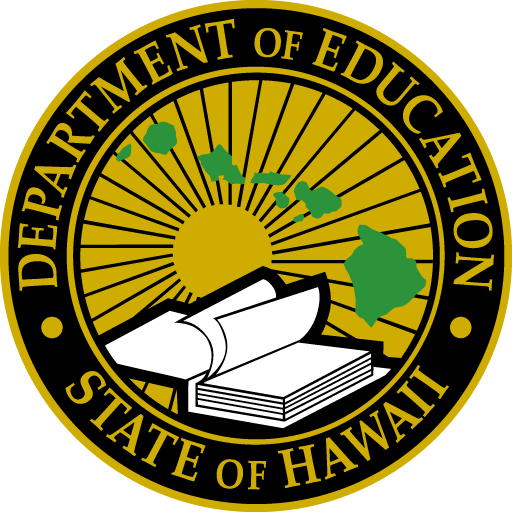Hawaiʻi’s public school 健康指南 promote student and staff well-being through policies on health education, nutrition, physical activity and professional development.
wellness in our public schools
指南
“Wellness” in our public schools includes a wellness committee, 营养 指导方针、健康教育、营养促进、体育教育、体育活动和员工专业发展。 健康指南 实施教育委员会 政策 103-1(PDF) 并满足要求 公法 108-265 第 204 条 (PDF) 和 健康饥饿儿童法案(2010).
现有译本:
Wellness Committee
All of our schools have a designated wellness coordinator and a committee that meets at least three times per year to address school health issues, including the implementation of the 健康指南. The wellness committee should consist of school administration, faculty and staff, as well as students, families and community representatives. The committee is responsible using data sources (e.g., Youth Risk Behavior Survey) to identify priority areas for the school’s Academic Plan.
At the beginning of each school year, each school community is notified about the wellness policy and provided with the wellness coordinator’s contact information. The schools also encourage students’ families to support wellness at school and at home.
有关您如何参与的更多信息:
Nutrition 指南
与从家里带午餐的学生相比,吃学校午餐的孩子更有可能食用牛奶、肉类、谷物和蔬菜。他们也往往摄入更多的营养——无论是在午餐时间还是在一整天的时间。我们优先确保学生获得营养丰富的膳食,以促进学习和体育活动。该部门在学年期间每天提供超过 100,000 份餐食。详细了解 营养 指导方针.
学校促进良好营养的方法:
- 校园里展示了有关营养食品的积极信息。
- 供学生使用的自动售货机只售有水。
- 学校餐食尽可能从零开始制作,包括新鲜出炉的全麦面包。
- 没有食物含有反式脂肪。
- 用餐期间,学生可以免费获得饮用水。
- 欢迎各班级参观食堂厨房,学习如何准备健康食品。
- 向学生及其家长推广健康的早餐、午餐和零食。
- 教学花园展示了食物是如何生长的。
健康教育和营养促进
健康教育 and nutrition promotion provide the instructional foundation that is necessary to prepare students to make lifelong healthy decisions and practice healthy behaviors. This component area of the 健康指南 包括在全校范围内推广营养餐和零食以及优质的健康教育。
指南 for health education and nutrition promotion are organized around 四个关键组成部分:
- 健康教育课程的教学内容重点关注支持健康饮食的知识和技能,并与 HIDOE 健康教育标准保持一致。
- 小学学生每周接受健康教育时间不少于45分钟,中学学生每周接受健康教育时间不少于200分钟。
- 营养教育包括以文化为基础、亲自动手的文化相关活动,例如食物准备、品尝、参观农场和学校花园。
- 所有学校食品和饮料营销必须符合 营养 指导方针。其中包括但不限于学校出版物、自动售货机外部、海报、横幅、校内电视和记分牌。
体育
目标 体育 体育课旨在帮助所有学生获得知识、技能和信心,让他们终身保持身体活跃。参加体育课还能帮助学生达到国家建议的每天 60 分钟身体活动量。
There are six 指导方针 to support PE:
- 体育课的教学内容与夏威夷教育部体育标准一致。
- 小学学生每周至少接受45分钟体育教育,中学学生每周至少接受200分钟体育教育。
- 体育课的时间中至少有 50% 用于中度到剧烈的体力活动。
- 体育课均由国家认证的体育教练授课。
- 体育课的师生比例与其他课程相似。
- 5、7 和 9 年级的体育教育包括与健康相关的学生体能评估(例如 FitnessGram)。
体力活動
定期进行体育锻炼可以强健骨骼和肌肉,提高肌肉力量和耐力,降低患慢性病的风险,提高自尊心,减轻压力和焦虑。研究还表明,体育锻炼有助于提高学生的学业成绩,包括成绩和标准化考试分数。
There are six 指导方针 to support physical activity:
- 学生每天有至少 20 分钟的休息时间,其中包括进行中度到剧烈的体育活动的机会。
- 每 60 分钟至少为学生提供一次体育活动休息时间。
- 学校不会将体育活动(例如课间休息或体育课)作为负面后果。
- 学校支持主动交通,鼓励学生和教职员工在安全的情况下步行和/或骑自行车上学。
- 学校为学生和教职员工提供自行车架。
- 学校工作人员、学生、家长和社区成员可以在非教学时间(即课前、课后、周末和节假日)进入校园并利用学校设施进行体育活动。
专业发展
In order to create a school community that is supportive of wellness, school staff are provided with opportunities for professional development relating to wellness. There are two 指导方针 支持专业发展:
- School staff receive annual professional development on the 健康指南.
- School staff are encouraged to be role models for wellness.
资源
- 健康指南 (PDF)
- 健康指南 Resource for Schools (需要 HIDOE 工作人员登录)
Local Wellness Policy Assessment
每三年评估一次
美国农业部(USDA) Final Rule: Local School Wellness Policy Implementation Under the HHFKA of 2010 requires all local educational agencies (LEAs) to establish the minimum requirements for local wellness policies and complete the 每三年评估一次 (PDF)适用于所有参加国家学校午餐计划和/或学校早餐计划的学校。
每三年,评估必须确定:
- Compliance with the wellness policy.
- How the wellness policy compares to model wellness policies.
- Progress made in attaining the goals of the wellness policy.
查看评估。
- 每三年评估一次 2022 年 7 月 (PDF)
- Triennial Assessment July, 2025 (PDF)
Safety and Wellness Survey (SAWS)
This annual online survey of public school principals is used to monitor and evaluate schools’ progress toward implementing the 健康指南. It is jointly administered by the Department of Education and Department of Health. Key indicators from the SAWS are included in the HIDOE’s annual report. View the latest Safety and Wellness Survey (PDF) 结果。
- Safety and Wellness Survey: 2023-24 (PDF)
- Safety and Wellness Survey: 2022-23 (PDF)
- Safety and Wellness Survey: 2021-22 (PDF)
美国农业部非歧视声明
根据联邦民权法和美国农业部 (USDA) 民权法规和政策,本机构禁止基于种族、肤色、国籍、性别(包括性别认同和性取向)、残疾、年龄或对先前民权活动的报复或报复而进行歧视。
计划信息可能以英语以外的其他语言提供。需要其他沟通方式(例如盲文、大字印刷品、录音带、美国手语)获取计划信息的残障人士应联系负责管理该计划的州或地方机构或美国农业部的 TARGET 中心,电话 (202) 720-2600(语音和 TTY),或通过联邦中继服务 (800) 877-8339 联系美国农业部。
要提出项目歧视投诉,投诉人应填写表格 AD-3027(美国农业部项目歧视投诉表),该表格可从以下网址在线获取: https://www.usda.gov/sites/default/files/documents/USDA-OASCR%20P-Complaint-Form-0508-0002-508-11-28-17Fax2Mail.pdf,可从任何 USDA 办公室拨打 (866) 632-9992 或写信给 USDA。信中必须包含投诉人的姓名、地址、电话号码以及对涉嫌歧视行为的书面描述,且描述应足够详细,以便向民权事务助理部长 (ASCR) 告知涉嫌侵犯民权的性质和日期。填妥的 AD-3027 表格或信函必须通过以下方式提交给 USDA:
- 邮件:
美国农业部
民权事务助理部长办公室
西南独立大道 1400 号
华盛顿特区 20250-9410;或 - 传真:
(833)256-1665 或 (202)690-7442;或 - 电子邮件:
[email protected]
该机构是一个平等机会提供者。
